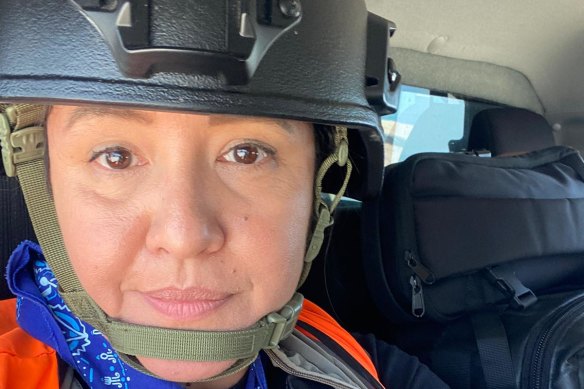
On the same day that Israeli F-35s launched missiles to kill several senior Iranian Revolutionary Guard Corps officers meeting in the Iranian embassy compound in Damascus, an Israeli drone killed an Australian aid worker and six of her colleagues delivering food to Palestinians in northern Gaza.
In the Syrian operation, precise intelligence was used against secretive, high-value targets in a foreign country’s capital. In Gaza, by contrast, a clearly marked aid convoy was attacked in benign circumstances and the aid workers killed, for no apparent reason.

A photo that Zomi Frankcom sent her family just before her death this week.
When it wants to, Israel can launch a highly precise strike against sensitive targets at the same time as minimising civilian casualties. In January, for example, an Israeli missile smashed into a third-floor apartment in Beirut’s southern suburbs and killed Saleh Arouri, Hamas’ deputy political chief. Clean, precise. But in Gaza, Israel’s military is far less clean, far less precise. Indeed, far less disciplined.
Israel’s military chief has come out after a preliminary assessment was conducted and apologised for the death of the aid workers, saying it shouldn’t have happened, that it was a mistake that followed a misidentification, but added that it was at night, in a war, in very complex conditions. Yet the vehicles were clearly identified, the Israeli military was allegedly advised of the convoy’s presence, and there was no fighting reported in the area. If such a grievous mistake was made in these conditions, how many targeting mistakes are made by conscripts and reservists when conditions really are complex?
One only needs to look back at the December killing by Israeli troops of three bare-chested Israeli hostages waving a white flag, who tried to seek safety among the army in which they had also served. Two were shot and killed by an Israeli soldier who identified them as a threat even though he “stood in a position with limited vision” and the third was killed after the commander ordered a ceasefire, but two soldiers hadn’t heard the order because of “noise from a nearby tank”. They shot and killed the hostage. Presumably they too identified the unarmed, bare-chested man as a threat before shooting him dead.
Loading
The problem in highlighting such egregious errors on the part of the Israeli military, of course, is that it is only the high-profile cases – when it kills foreign aid workers or its own hostages – where the public gets any insight into its targeting protocols, rules of engagement and individual fire discipline. In response to the killing of three hostages who posed no threat and held up a white flag, the Israeli chief of staff reminded his troops that “where there is no immediate threat and the identification is not a clear enemy, there is a need for a moment of examination before firing … This action is necessary to prevent, among other things, incidents of our forces firing at our forces”. Mistakenly firing on Palestinian civilians is presumably one of the “other things” to which he referred.
Imagine how many other incidents don’t make the media, but which involve Palestinian civilians in Gaza being killed, and where the Israeli military has neither the time nor the inclination to investigate. If an aid convoy whose presence was known in advance, and which was clearly marked, can be “misidentified” and destroyed in a few minutes by a drone, then what other Palestinian targets have been engaged on suspicion? And if three shirtless Israeli hostages holding a white flag can be gunned down by their own troops, how discerning are other Israeli soldiers going to be in determining whether unarmed Gazans do or do not pose a threat before they open fire?
Reports of Israel using AI to generate target lists in Gaza raises further questions about Israel’s concern over civilian casualties.



























